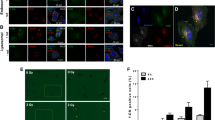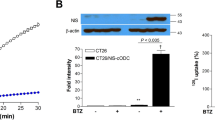Abstract
The sodium iodide symporter (NIS) mediates iodide uptake into thyrocytes and is the molecular basis of thyroid radioiodine therapy. We previously have shown that NIS gene transfer into the F98 rat gliomas facilitated tumor imaging and increased survival by radioiodine. In this study, we show that: (1) the therapeutic effectiveness of 131I in prolonging the survival time of rats bearing F98/hNIS gliomas is dose- and treatment-time-dependent; (2) the number of remaining NIS-expressing tumor cells decreased greatly in RG2/hNIS gliomas post 131I treatment and was inversely related to survival time; (3) 8 mCi each of 125I/131I is as effective as 16 mCi 131I alone, despite a smaller tumor absorbed dose; (4) 188ReO4, a potent β− emitter, is more efficient than 131I to enhance the survival of rats bearing F98/hNIS gliomas. These studies demonstrate the importance of radiopharmaceutical selection, dose, and timing of treatment to optimize the therapeutic effectiveness of NIS-targeted radionuclide therapy following gene transfer into gliomas.
This is a preview of subscription content, access via your institution
Access options
Subscribe to this journal
Receive 12 print issues and online access
$259.00 per year
only $21.58 per issue
Buy this article
- Purchase on Springer Link
- Instant access to full article PDF
Prices may be subject to local taxes which are calculated during checkout



Similar content being viewed by others
References
Dai G, Levy O, Carrasco N . Cloning and characterization of the thyroid iodide transporter. Nature 1996; 379: 458–460.
Smanik PA et al. Cloning of the human sodium lodide symporter. Biochem Biophys Res Commun 1996; 226: 339–345.
Shimura H et al. Iodide uptake and experimental 131I therapy in transplanted undifferentiated thyroid cancer cells expressing the Na+/I− symporter gene. Endocrinology 1997; 138: 4493–4496.
Mandell RB, Mandell LZ, Link Jr CJ . Radioisotope concentrator gene therapy using the sodium/iodide symporter gene. Cancer Res 1999; 59: 661–668.
Cho JY et al. In vivo imaging and radioiodine therapy following sodium iodide symporter gene transfer in animal model of intracerebral gliomas. Gene Therapy 2002; 9: 1139–1145.
La Perle KM et al. In vivo expression and function of the sodium iodide symporter following gene transfer in the MATLyLu rat model of metastatic prostate cancer. Prostate 2002; 50: 170–178.
Boland A et al. Adenovirus-mediated transfer of the thyroid sodium/iodide symporter gene into tumors for a targeted radiotherapy. Cancer Res 2000; 60: 3484–3492.
Nakamoto Y et al. Establishment and characterization of a breast cancer cell line expressing Na+/I- symporters for radioiodide concentrator gene therapy. J Nucl Med 2000; 41: 1898–1904.
Haberkorn U et al. Transfer of the human NaI symporter gene enhances iodide uptake in hepatoma cells. J Nucl Med 2001; 42: 317–325.
Spitzweg C et al. Prostate-specific antigen (PSA) promoter-driven androgen-inducible expression of sodium iodide symporter in prostate cancer cell lines. Cancer Res 1999; 59: 2136–2141.
Carlin S et al. Experimental targeted radioiodide therapy following transfection of the sodium iodide symporter gene: effect on clonogenicity in both two- and three-dimensional models. Cancer Gene Ther 2000; 7: 1529–1536.
Spitzweg C et al. In vivo sodium iodide symporter gene therapy of prostate cancer. Gene Therapy 2001; 8: 1524–1531.
Prados MD, Levin V . Biology and treatment of malignant glioma. Semin Oncol 2000; 27: 1–10.
Brandes AA, Rigon A, Monfardini S . Radiotherapy of the brain in elderly patients. Contra Eur J Cancer 2000; 36: 447–451; discussion 451–442.
Grau JJ, Verger E . Radiotherapy of the brain in elderly patients. Pro Eur J Cancer 2000; 36: 443–447.
Wheldon TE . Radiation physics and genetic targeting: new directions for radiotherapy. The Douglas Lea Lecture 1999. Phys Med Biol 2000; 45: R77–R95.
McDermott MW, Gutin PH, Larson DA, Sneed PK . Interstitial brachytherapy. Neurosurg Clin N Am 1990; 1: 801–824.
Mann BD et al. Imaging of human tumor xenografts in nude mice with radiolabeled monoclonal antibodies. Limitations of specificity due to nonspecific uptake of antibody. Cancer 1984; 54: 1318–1327.
Goodwin DA . Pharmacokinetics and antibodies. J Nucl Med 1987; 28: 1358–1362.
Goodwin DA et al. Pre-targeted immunoscintigraphy of murine tumors with indium-111-labeled bifunctional haptens. J Nucl Med 1988; 29: 226–234.
Riva P et al. Local application of radiolabeled monoclonal antibodies in the treatment of high grade malignant gliomas: a six-year clinical experience. Cancer 1997; 80: 2733–2742.
Riva P et al. Loco-regional radioimmunotherapy of high-grade malignant gliomas using specific monoclonal antibodies labeled with 90Y: a phase I study. Clin Cancer Res 1999; 5: 3275s–3280s.
Riva P et al. 131I radioconjugated antibodies for the locoregional radioimmunotherapy of high-grade malignant glioma – phase I and II study. Acta Oncol 1999; 38: 351–359.
Riva P et al. Role of nuclear medicine in the treatment of malignant gliomas: the locoregional radioimmunotherapy approach. Eur J Nucl Med 2000; 27: 601–609.
Weber DA . MIRD: Radionuclide Data and Decay Schemes. The Society of Nuclear Medicine: New York, 1989.
Laperriere N, Zuraw L, Cairncross G . Radiotherapy for newly diagnosed malignant glioma in adults: a systematic review. Radiother Oncol 2002; 64: 259–273.
Maxon HR, Thomas SR, Samaratunga RC . Dosimetric considerations in the radioiodine treatment of macrometastases and micrometastases from differentiated thyroid cancer. Thyroid 1997; 7: 183–187.
Loevinger R, Budinger TF, Watson EE . MIRD Primer For Absorbed Dose Calculation. The Society of Nuclear Medicine: New York, NY, 1991.
Casara D et al. Different features of pulmonary metastases in differentiated thyroid cancer: natural history and multivariate statistical analysis of prognostic variables. J Nucl Med 1993; 34: 1626–1631.
Sherman SI . The management of metastatic differentiated thyroid carcinoma. Rev Endocr Metab Disord 2000; 1: 165–171.
O'Donoghue JA, Bardies M, Wheldon TE . Relationships between tumor size and curability for uniformly targeted therapy with beta-emitting radionuclides. J Nucl Med 1995; 36: 1902–1909.
de Jong M et al. Tumor response after [(90)Y-DOTA(0),Tyr(3)]octreotide radionuclide therapy in a transplantable rat tumor model is dependent on tumor size. J Nucl Med 2001; 42: 1841–1846.
Knedlitschek G, Anderer U, Weibezahn KF, Dertinger H . Radioresistance of rat glioma cell lines cultured as multicellular spheroids. Correlation with electrical cell-to-cell-coupling. Strahlenther Onkol 1990; 166: 164–167.
Bloomer WD, McLaughlin WH, Adelstein SJ, Wolf AP . Therapeutic applications of Auger and alpha emitting radionuclides. Strahlentherapie 1984; 160: 755–757.
O'Donoghue JA, Wheldon TE . Targeted radiotherapy using Auger electron emitters. Phys Med Biol 1996; 41: 1973–1992.
O'Donoghue JA . Strategies for selective targeting of Auger electron emitters to tumor cells. J Nucl Med 1996; 37: 3S–6S.
Cunningham SH et al. Toxicity to neuroblastoma cells and spheroids of benzylguanidine conjugated to radionuclides with short-range emissions. Br J Cancer 1998; 77: 2061–2068.
Dadachova E, Bouzahzah B, Zuckier LS, Pestell RG . Rhenium-188 as an alternative to Iodine-131 for treatment of breast tumors expressing the sodium/iodide symporter (NIS). Nucl Med Biol 2002; 29: 13–18.
Knapp Jr FF et al. Endovascular beta irradiation for prevention of restenosis using solution radioisotopes: pharmacologic and dosimetric properties of rhenium-188 compounds. Cardiovasc Radiat Med 1999; 1: 86–97.
Lin WY et al. A comprehensive study on the blockage of thyroid and gastric uptakes of 188Re-perrhenate in endovascular irradiation using liquid-filled balloon to prevent restenosis. Nucl Med Biol 2000; 27: 83–87.
Josefsson M, Grunditz T, Ohlsson T, Ekblad E . Sodium/iodide-symporter: distribution in different mammals and role in entero-thyroid circulation of iodide. Acta Physiol Scand 2002; 175: 129–137.
Knapp Jr FF . Rhenium-188 – a generator-derived radioisotope for cancer therapy. Cancer Biother Radiopharm 1998; 13: 337–349.
Knapp Jr FF et al. Reactor-produced radioisotopes from ORNL for bone pain palliation. Appl Radiat Isot 1998; 49: 309–315.
O'Donoghue J . Dosimetric Principles of Targeted Radiotherapy. In: Abrams PG FA (ed). Radioimmunotherapy of Cancer. Marcel Dekker: New York, 2000, pp 1–21.
Petrich T et al. Establishment of radioactive astatine and iodine uptake in cancer cell lines expressing the human sodium/iodide symporter. Eur J Nucl Med Mol Imaging 2002; 29: 842–854.
Carlin S, Mairs RJ, Welsh P, Zalutsky MR . Sodium-iodide symporter (NIS)-mediated accumulation of [(211)At]astatide in NIS-transfected human cancer cells. Nucl Med Biol 2002; 29: 729–739.
Kobayashi N, Allen N, Clendenon NR, Ko LW . An improved rat brain-tumor model. J Neurosurg 1980; 53: 808–815.
Clendenon NR et al. Enhanced survival in a rat glioma model following BNCT. Strahlenther Onkol 1989; 165: 222–225.
Acknowledgements
We are indebted to our Nuclear Medicine colleagues of The Ohio State University Hospital, including Ms Bonnie Williams, Mr Cowan Edwards, Mr Aaron Haynam, and Ms Mary Morgan for their preparation of radionuclides and providing gamma camera assistance. We also thank Dr FF Russ Knapp at the Oak Ridge National Lab for his consultation regarding use of the 188Tungsten/188Rhenium generator. This work was partly supported by DOD Prostate Cancer Research Program DAMD 17-02-0119 (to SMJ), and the statistical analyses were supported by NIH Grant #MO1 RR00034 (to HNN via OSU GCRC).
Author information
Authors and Affiliations
Rights and permissions
About this article
Cite this article
Shen, D., Marsee, D., Schaap, J. et al. Effects of dose, intervention time, and radionuclide on sodium iodide symporter (NIS)-targeted radionuclide therapy. Gene Ther 11, 161–169 (2004). https://doi.org/10.1038/sj.gt.3302147
Received:
Accepted:
Published:
Issue Date:
DOI: https://doi.org/10.1038/sj.gt.3302147
Keywords
This article is cited by
-
Molecular imaging of cellular immunotherapies in experimental and therapeutic settings
Cancer Immunology, Immunotherapy (2022)
-
Sodium iodide symporter (NIS) in extrathyroidal malignancies: focus on breast and urological cancer
BMC Cancer (2014)
-
Combining transfer of TTF-1 and Pax-8 gene: a potential strategy to promote radioiodine therapy of thyroid carcinoma
Cancer Gene Therapy (2012)
-
Isolated System Towards A Successful Radiotherapy Treatment
Nuclear Medicine and Molecular Imaging (2010)
-
Rat brain tumor models in experimental neuro-oncology: the C6, 9L, T9, RG2, F98, BT4C, RT-2 and CNS-1 gliomas
Journal of Neuro-Oncology (2009)



